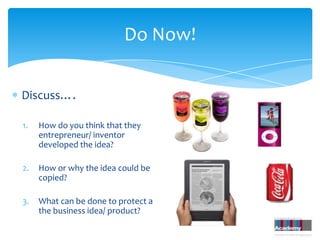
1.2 generating and protecting business ideas - moodle
- 1. Do Now! Discuss…. 1. How do you think that they entrepreneur/ inventor developed the idea? 2. How or why the idea could be copied? 3. What can be done to protect a the business idea/ product?
- 2. Generating and Protecting Business Ideas
- 3. Learning Objectives By the end of this lesson you should be able to: 1. Identify the main source of ideas for new business start- ups and understand and how entrepreneurs identify and exploit a market niche. 2. Analyse the role of patents, copyrights and trademarks as methods of protecting business ideas. 3. Evaluate the benefits and disadvantages of franchising as a way to start a business.
- 4. The Pure Package Discuss…. 1. What are the main reasons why Jennifer decided to start her business? 2. Create a spider diagram to illustrate the strengths and weaknesses of her early decision when starting up. LO1) Identify the main sources of ideas for new business start-ups and understand and how entrepreneurs identify and exploit a market niche.
- 5. Sources of Business ideas What will an entrepreneur often based new business ideas on? Experience of a product or service Hobby or interest Realisation that there is a ‘niche’ or ‘gap in the market’ LO1) Identify the main sources of ideas for new business start-ups and understand and how entrepreneurs identify and exploit a market niche.
- 6. Sources of Business ideas For each of the following write down a benefit and drawback Knowing the Spotting a gap in product or the market service LO1) Identify the main sources of ideas for new business start-ups and understand and how entrepreneurs identify and exploit a market niche.
- 7. Small Budget Research – why is this so important? Use business directories such as the Yellow Pages. Geographical mapping – locate existing competition or ID gaps in the market. Local and national demographic data – identify potential market features. Questionnaires or interviews. Market mapping – to identify market segments. LO1) Identify the main sources of ideas for new business start-ups and understand and how entrepreneurs identify and exploit a market niche.
- 8. Market Mapping – Can you identify a gap in the market? Add the following FAST FOOD outlets…. Burger King McDonalds Fish ‘n’ chips M&S Sandwich Subway Did you find any gaps? LO1) Identify the main sources of ideas for new business start-ups and understand and how entrepreneurs identify and exploit a market niche.
- 9. Why would an entrepreneur want to protect a business idea? LO2) Analyse the role of patents, copyrights and trademarks as methods of protecting business ideas.
- 10. Protecting Business Ideas A word, image, sound or smell that enables a Copyright business to differentiate itself from its competitors. Protection given to books, plays, films and Patent musicals. An exclusive right to use, process and Trademark produce a product, usually for a fixed period of time, up to 20 years.
- 11. Protecting Business Ideas LO2) Analyse the role of patents, copyrights and trademarks as methods of protecting business ideas.
- 12. Dyson Wins Hoover Case Discuss…. 1. Consider the benefits to James Dyson of the protection that a patent gave his business. 2. To what extent does a patent give a business such as Dyson an unfair advantage over competition? LO2) Analyse the role of patents, copyrights and trademarks as methods of protecting business ideas.
- 13. What is a franchise? 2 minute challenge….. Examples include: Investors Write a definition of Lenders franchise…. Creditors Customers Employees Government Analysts Media But why would they want this information?
- 14. What is a franchise? Franchise – The owner of a business idea (franchisor) sells the right to use that idea to another person (franchisee). This is usually in return for a fee and a share in any profits that the franchisee makes. LO3) Evaluate the benefits and disadvantages of franchising as a way to start a business.
- 15. Test your franchise knowledge Complete the worksheet t0 see what you remember…. Prepare to share your answers LO3) Evaluate the benefits and disadvantages of franchising as a way to start a business.
- 16. Finally…. Write down one question, based on todays lesson. Use your question to test your peers.
- 17. Re-cap Learning Objectives You should now be able to: 1. Identify the main source of ideas for new business start- ups and understand and how entrepreneurs identify and exploit a market niche. 2. Analyse the role of patents, copyrights and trademarks as methods of protecting business ideas. 3. Evaluate the benefits and disadvantages of franchising as a way to start a business.
Notes de l'éditeur
- Case study P10
- See o
- May get asked about small budget/ start-up research (consider small budget)
- Don’t steal ideaProtect investmentNeed for new innovations/ inventions
- Stand-up if your bday is in Jan to March – utilise for questioning why?